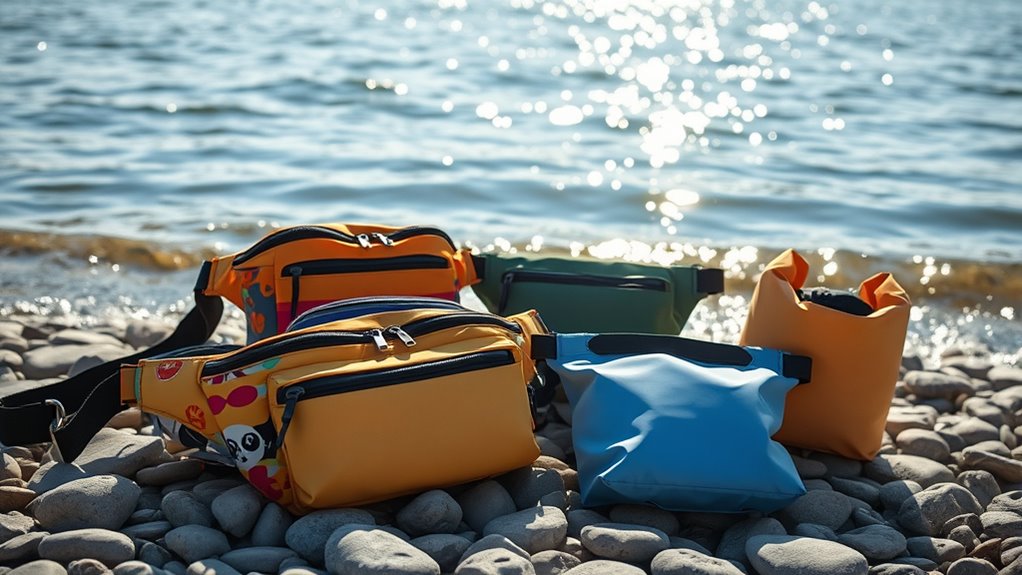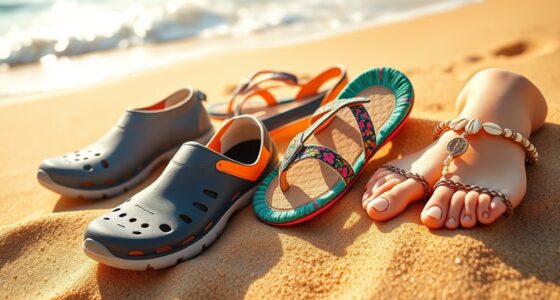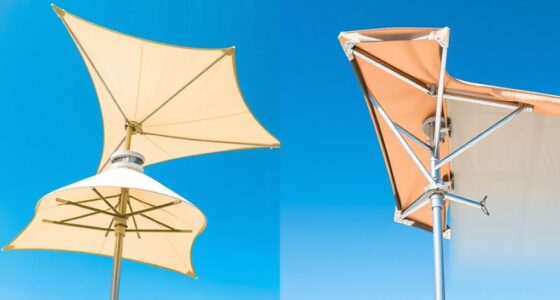If you’re choosing between fanny packs and dry bags for waterside valuables, consider durability, water resistance, and ease of access. Fanny packs are lightweight, easy to reach, and suitable for casual use, but they may not withstand tough conditions long-term. Dry bags offer superior water protection, better organization, and greater durability for active water activities. To find the best fit for your needs, explore how each option balances security, comfort, and longevity as you continue your search.
Key Takeaways
- Dry bags generally provide superior water resistance and durability, ideal for protecting valuables during water activities.
- Fanny packs offer quick access and convenience for small essentials but may be less waterproof and secure.
- Dry bags feature roll-top closures for reliable sealing, whereas fanny packs rely on waterproof zippers that can fail over time.
- Fanny packs are more versatile and easier to carry for casual outings, while dry bags excel in rugged, water-intensive environments.
- For maximum protection of valuables from water and damage, dry bags are typically the better choice.
Material and Durability
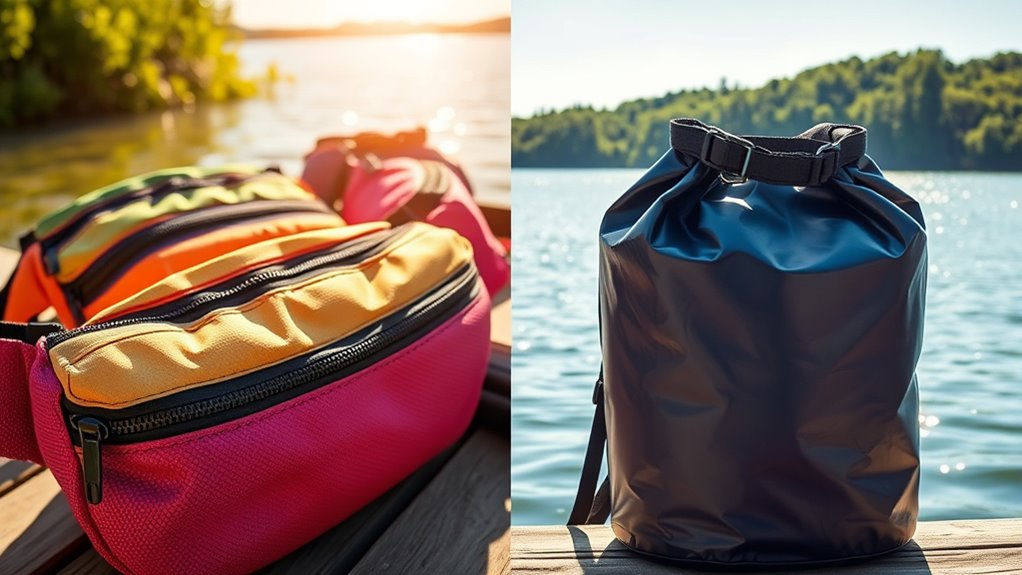
When choosing between a fanny pack and a dry bag for waterside activities, understanding their material and durability is essential. Fanny packs are typically made from lightweight fabrics like nylon or polyester, which offer decent resistance but can tear or wear over time if exposed to rough conditions. Dry bags, on the other hand, are constructed from more robust materials like PVC, tarpaulin, or TPU, designed specifically to withstand water, abrasions, and rough handling. They’re generally more durable and provide better protection against punctures and tears. Material strength plays a crucial role in determining how well these bags hold up over time and under challenging conditions. If you plan to be in rugged environments or handle your valuables frequently, a dry bag’s stronger material ensures longevity and reliable protection. Additionally, material flexibility can influence how easily these bags are packed or carried in different situations. Conversely, a fanny pack’s lighter material offers convenience but less durability for intense waterside activities.
Water Resistance Capabilities
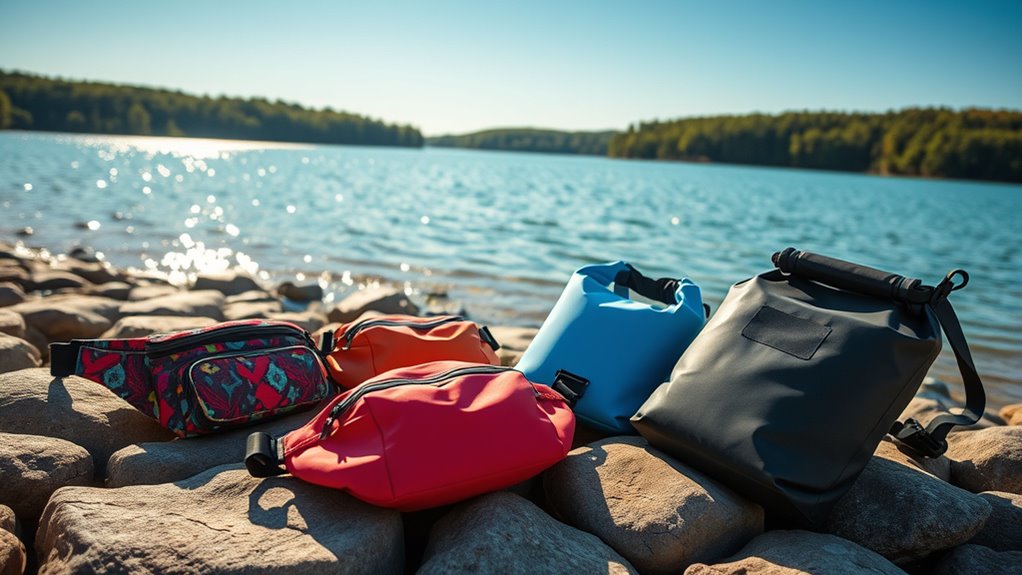
You need to take into account the waterproof materials used in each option, as they directly affect how well your valuables stay dry. The sealing and closure mechanisms also play a vital role in preventing water from seeping in during splashes or submersion. Choosing a product with reliable sealing features ensures your belongings remain protected in wet conditions. Additionally, some waterproof technologies incorporate sensors and automatic sealing functions that can further enhance water resistance during use. Considering waterproof material quality is essential for long-term durability and performance in aquatic environments. Dog names can also be a fun way to personalize your gear, making it easier to identify your pack or bag among others. As advancements in waterproof material development continue, products are increasingly capable of providing reliable protection against water damage over time. Incorporating sound healing science insights into product design can also improve user confidence by leveraging proven protective features.
Waterproof Materials Used
Both fanny packs and dry bags rely on specialized waterproof materials to protect valuables from water exposure. Fanny packs often use coated nylon or polyester fabrics, which are lightweight and flexible, offering good water resistance but not complete waterproofing. Dry bags, on the other hand, typically feature thicker materials like PVC or tarpaulin, providing a higher level of waterproof protection. Some dry bags also incorporate laminated fabrics with welded seams to prevent water ingress. The choice of material directly impacts durability, weight, and water resistance. While fanny packs focus on comfort and ease of access, dry bags prioritize maximum waterproofing, often at the expense of flexibility. Understanding these material differences helps you choose the right option for your waterside adventures. Additionally, the materials used in water-resistant gear are often selected for their ability to withstand rugged outdoor conditions, ensuring long-lasting protection. Selecting appropriate waterproof materials can significantly extend the lifespan and effectiveness of your water protection gear, especially when considering the water resistance capabilities required for different environments.
Sealing and Closure Effectiveness
The effectiveness of sealing and closures plays a key role in how well fanny packs and dry bags protect valuables from water. A secure seal prevents water from seeping in during splashes, rain, or submersion. Fanny packs often use zipper closures with waterproof coatings or flaps, but these can sometimes fail under pressure or with frequent use. Dry bags typically feature roll-top closures that create a tight, watertight seal when correctly rolled and clipped. To guarantee maximum protection, always verify that closures are properly sealed and free of damage. Regularly inspect zippers and roll-top mechanisms for wear or debris. Proper sealing is essential; even a tiny gap can compromise your valuables, so double-check each closure before exposing your gear to water. Incorporating self-awareness about the condition of your gear and its closure mechanisms can help ensure optimal water resistance. Additionally, understanding the importance of water resistance capabilities can guide you in selecting the most reliable sealing method for your needs. Keeping closure mechanisms clean and free from dirt enhances their ability to form a secure seal. Remember that closure maintenance extends the lifespan of your water-resistant gear and enhances its effectiveness over time. Paying attention to material quality can also influence the durability and overall water resistance of your gear.
Ease of Access and Convenience
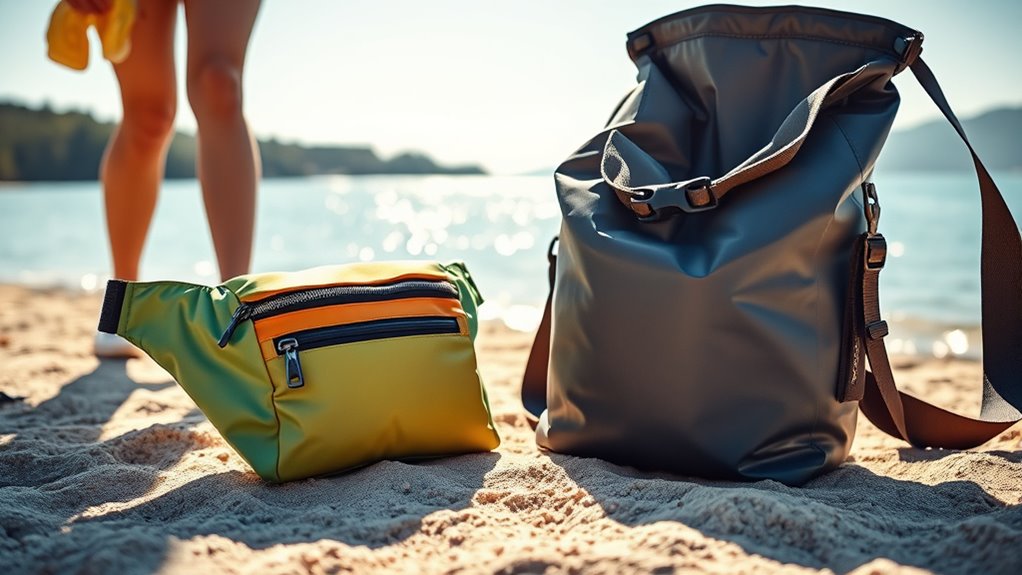
When it comes to quick and effortless access to your valuables, dry bags generally have the edge over fanny packs. Dry bags often feature roll-top closures or waterproof zippers that keep your items secure while still allowing easy opening. You can quickly unzip or unfold them without fumbling through multiple compartments. Fanny packs, on the other hand, usually have zippers and multiple pockets that might require more effort to access. However, their design allows you to reach items without removing the bag, which is convenient when you’re on the water or moving around. Still, if speed is a priority, dry bags tend to be more straightforward for grabbing essentials swiftly. Overall, dry bags simplify access, making them slightly more convenient for quick retrieval of valuables. Additionally, resources and tools available for different water sports can help you select the best type of bag for your needs. For example, some dry bags are designed with easy-access features to further enhance convenience during active water activities.
Comfort and Fit

Since comfort and fit directly impact your waterside experience, choosing the right accessory is essential. Fanny packs usually sit snugly around your waist, providing stability without feeling bulky. Make sure the strap is adjustable so you can customize the fit and avoid chafing. Dry bags, on the other hand, are often designed to be handheld or worn with shoulder straps, which may not contour to your body as easily. If you prefer hands-free convenience, opt for a dry bag with a comfortable shoulder strap. Consider the weight of your valuables too; heavy items can cause discomfort if the strap isn’t padded or adjustable. Ultimately, the best choice feels secure without restricting movement, allowing you to enjoy your waterside activities comfortably. Choosing an accessory with proper materials can also enhance durability and ensure it withstands exposure to water and outdoor elements. Incorporating ergonomic design principles can further improve comfort during extended use. Additionally, selecting items with water-resistant features can help protect your valuables from moisture and damage, and paying attention to breathability can prevent excessive sweating and discomfort during prolonged wear. Ensuring your chosen accessory has adjustable straps allows for a better fit and increased comfort over long periods.
Storage Capacity and Organization
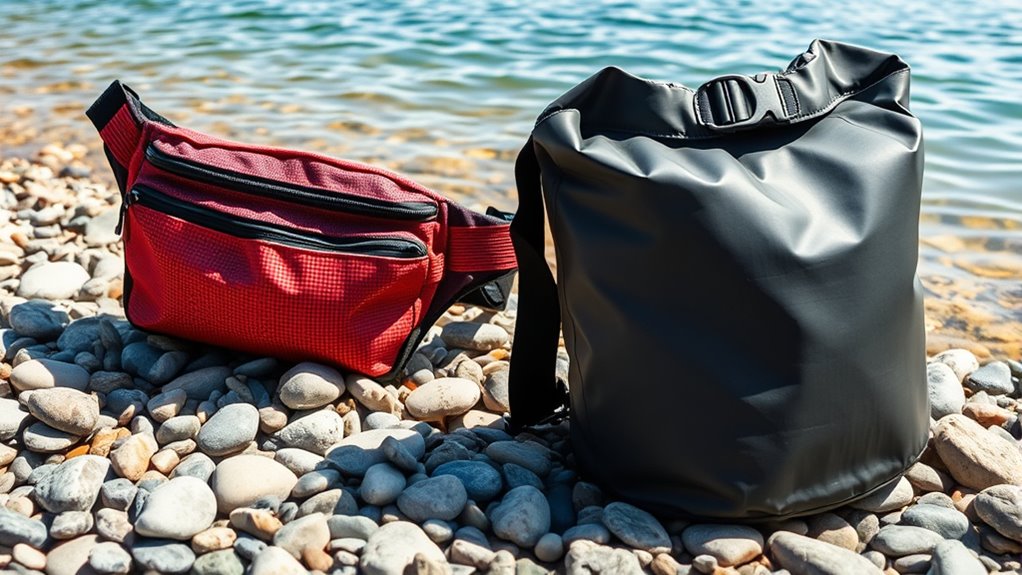
You need to contemplate how much space you’ll require for your valuables and how well they’ll stay organized. Fanny packs offer compact storage, making it easy to keep essentials within reach. Dry bags provide spacious compartments, giving you more room for larger items and better organization. Additionally, considering storage efficiency can help determine which option best suits your needs. For example, choosing a dry bag with multiple compartments can enhance organization capabilities, ensuring items are easy to find and access. When planning your waterside adventures, understanding state tax implications for IRA withdrawals can also influence your overall budget and financial strategy.
Fanny Packs: Compact Organization
Fanny packs excel at providing compact organization, making it easy to keep your essentials within reach without bulk. They’re designed to streamline your belongings, so you can move freely without feeling weighed down. With a fanny pack, you get a few key compartments that keep things in order:
- A main pocket for your phone, wallet, and keys
- Small external zippered pockets for quick-access items
- Slim interior compartments for organization without bulk
This setup ensures your valuables stay secure and easy to find, even when you’re on the move. The size and layout make it ideal for waterside activities where you want to stay hands-free but still have quick access to your essentials.
Dry Bags: Spacious Storage
Dry bags prioritize spacious storage, making them ideal for carrying larger or multiple items without sacrificing organization. They typically feature a roll-top closure that creates a waterproof seal, ensuring everything inside stays dry. You can pack clothes, snacks, electronics, and even small gear without worry. Many dry bags come with internal compartments or mesh pockets, helping you stay organized and easily find what you need. The wide opening allows for quick packing and unloading, saving you time and effort. Their durable, waterproof material provides confidence during water activities, whether you’re kayaking, paddleboarding, or spending a day at the beach. Overall, dry bags offer ample space and flexible organization options, making them a practical choice for waterside adventures where you need to carry a variety of belongings securely.
Security and Theft Prevention
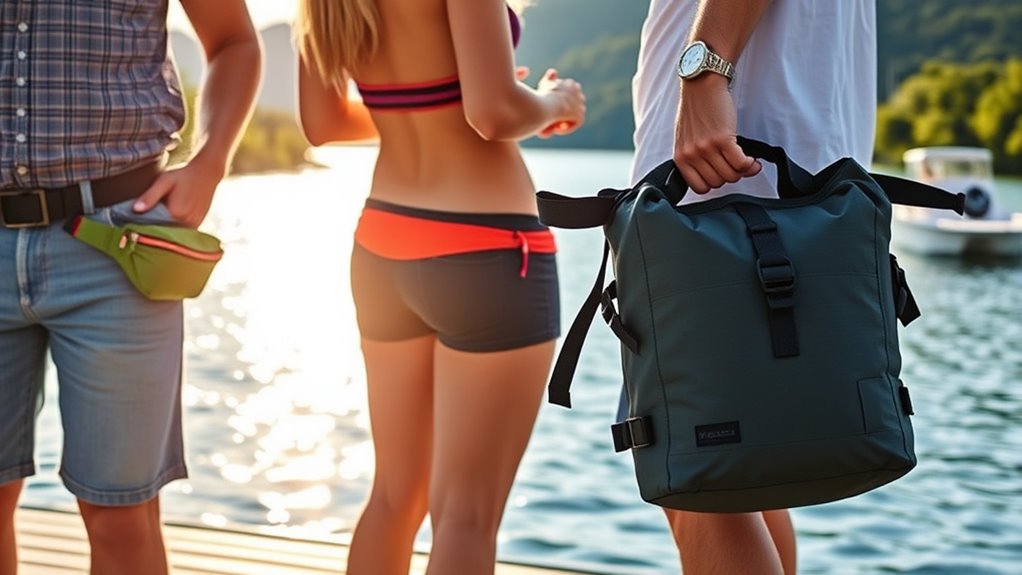
When it comes to safeguarding your valuables at the water’s edge, choosing the right carrying option can make a significant difference. Fanny packs and dry bags each offer different security features. To prevent theft, consider these key points:
- Visibility: Keep valuables hidden and out of sight to avoid attracting attention.
- Fastening: Ensure zippers or closures are secure, making it harder for thieves to access your belongings.
- Location: Keep your bag close and within your line of sight, whether strapped to your waist or held securely.
Fanny packs are more accessible but can be easier targets if left unattended. Dry bags, especially those with secure closures, offer better theft prevention when kept close. Prioritize security measures based on your activity and environment.
Versatility for Different Activities

Choosing the right carrying option depends largely on the activities you plan to do by the water. Fanny packs offer quick access and are great for casual outings, like strolling along the shoreline or short kayak trips. Dry bags excel in more active or extended water activities, such as paddleboarding or rafting, where keeping belongings dry is critical. Consider how you’ll move:
| Activity Type | Best Carrying Option |
|---|---|
| Light walking, relaxing | Fanny pack |
| Water sports, kayaking | Dry bag |
| Multi-hour excursions | Dry bag |
If you’re mainly lounging or sightseeing, a fanny pack provides convenience. For more intense water activities or longer trips, a dry bag’s waterproof protection becomes essential. Choose based on your activity’s demands.
Maintenance and Longevity
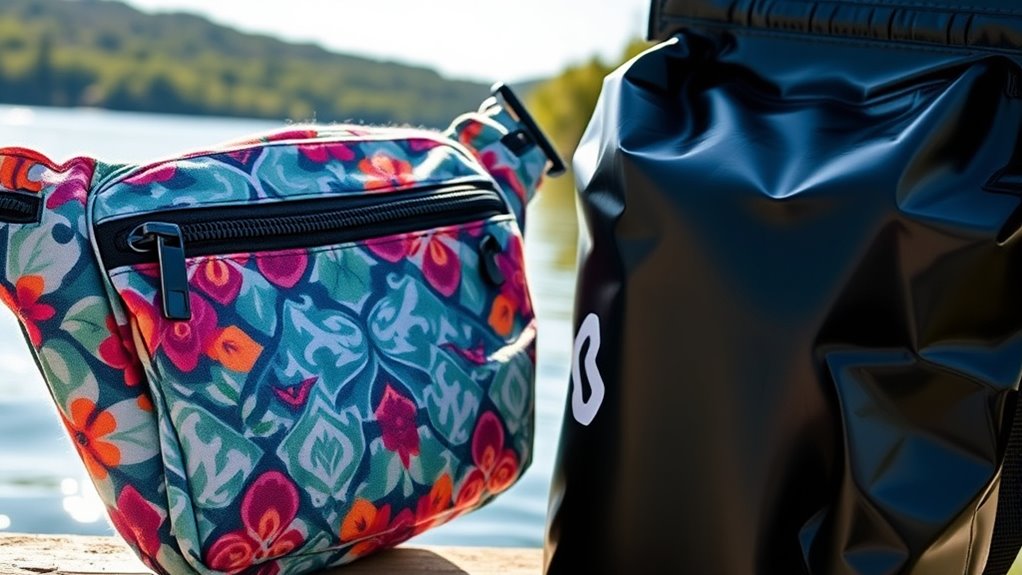
Maintaining your water gear properly can substantially extend its lifespan, regardless of whether you opt for a fanny pack or a dry bag. To keep your gear in top shape, focus on these key steps:
- Rinse with fresh water after every use to remove salt, dirt, and debris.
- Dry thoroughly before storing to prevent mold and mildew.
- Regularly inspect seals and zippers, replacing them if damaged.
Frequently Asked Questions
Can Both Options Be Used Underwater Safely?
You wonder if both options can be used underwater safely. While dry bags are specifically designed to be waterproof and protect valuables submerged, fanny packs are usually not waterproof unless explicitly made for water activities. If you want to keep your items dry underwater, use a dry bag. Fanny packs are better suited for light water exposure but aren’t reliable for full submersion. Always check product specifications before use.
Which Option Is Better for Prolonged Water Exposure?
When facing prolonged water exposure, you need a reliable way to keep your valuables dry. Dry bags are the better choice because they’re specifically designed to be waterproof and protect contents even after extended immersion. Fanny packs, on the other hand, often aren’t fully waterproof and may let water seep in over time. So, for long water adventures, select a dry bag to guarantee your valuables stay dry and safe.
Are There Style Differences Between Fanny Packs and Dry Bags?
Imagine choosing between a sleek backpack and a rugged toolbox; both serve their purpose but have different styles. Similarly, fanny packs have a casual, trendy look with vibrant colors and flexible designs, perfect for everyday wear. Dry bags lean towards a utilitarian, waterproof style, often in neutral tones. Your choice depends on whether you want fashion or function, but both can be stylish in their own right.
How Do They Compare in Weight and Bulkiness?
When comparing weight and bulkiness, fanny packs are generally lighter and more compact, making them easy to carry all day. Dry bags tend to be bulkier and heavier because they’re designed to protect valuables from water, often with thicker material and additional sealing features. If you’re active and prefer minimal weight, a fanny pack is a great choice. For maximum waterproof protection with less concern for bulk, opt for a dry bag.
Which Offers Better Protection Against Accidental Drops?
When considering protection against accidental drops, dry bags generally offer better security because they’re made from durable, waterproof materials that resist impact and keep contents sealed. Fanny packs, while convenient, are more prone to damage and may not provide enough cushioning if dropped. You’ll want to choose a dry bag if safeguarding valuables is your priority, especially around water where drops are more likely.
Conclusion
Choosing between a fanny pack and a dry bag is like picking your side in a classic adventure—each has its own strengths. Think of the dry bag as your trusty shield, keeping valuables safe, while the fanny pack is your quick-access sidekick. Whichever you choose, remember that your waterside adventure is your odyssey. With the right gear, you’ll channel your inner Indiana Jones, ready for whatever comes your way—safe, organized, and ready to enjoy the water.

